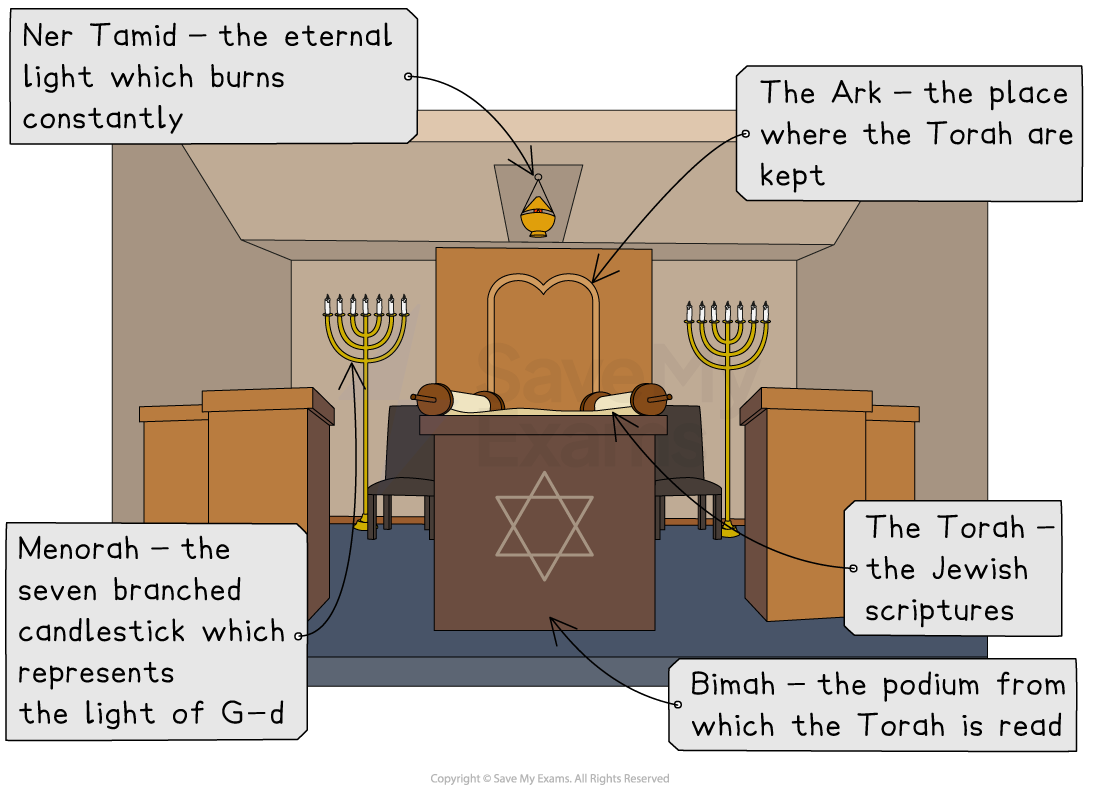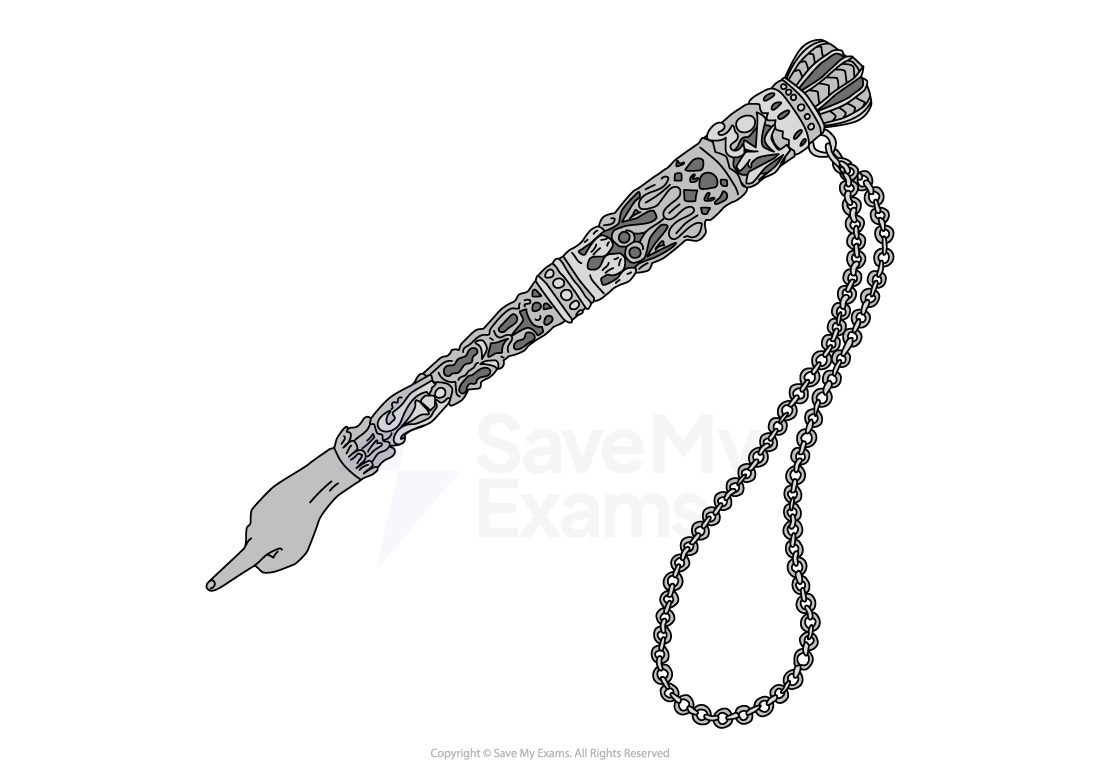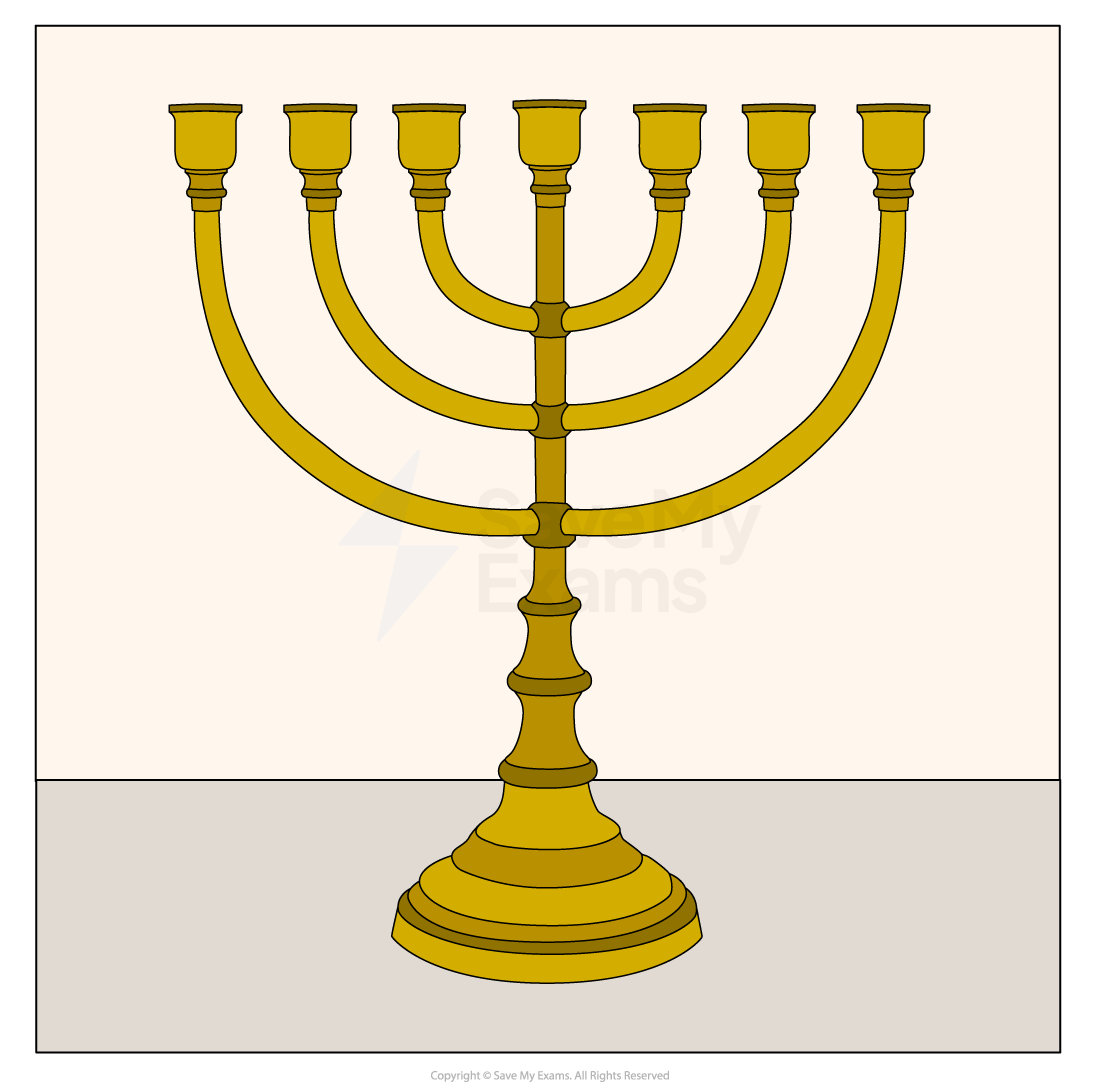Features & Functions of the Synagogue (WJEC Eduqas GCSE Religious Studies): Revision Note
Exam code: C120
The features of the synagogue
What is the Aron Hakodesh?

All synagogues have a large cupboard facing Jerusalem called the Aron Hakodesh
This is the holiest place in the synagogue
It is the centrepiece of the synagogue and holds the Torah scrolls, which contain the first five books of the Hebrew Bible
It is usually located on the eastern wall of the synagogue, facing Jerusalem
It often has a curtain or door in front of it called the parochet, similar to the curtain in the ancient Temple in Jerusalem
Why is the Aron Hakodesh significant?
The Aron Hakodesh is extremely significant within the Jewish faith
It symbolises the Ark of the Covenant, which held the stone tablets of the Ten Commandments in the time of Moses
It represents the holiness of the Torah and God's presence
It reminds Jews of the Temple in Jerusalem
Standing and showing respect when the Ark is opened is an important part of many services
What is the Sefer Torah?
The Sefer Torah is a scroll kept inside the Aron Hakodesh
It is written by a sofer (scribe) on parchment made from animal skin, using a quill and special ink and covered with a mantle or cloth that is ornately decorated
It can take over a year to complete a single scroll because even a single mistake can make it invalid
Why is the Sefer Torah important?
The Sefer Torah is considered to be the word of God, given to Moses on Mount Sinai
It is used within Jewish worship on several occasions
The Sefer Torah is read publicly during synagogue services on certain days
Shabbat (Saturday)
Mondays and Thursdays
Jewish festivals
Jews show great respect for the Torah
They stand when it is carried
It is dressed in a mantle (cloth cover), with decorations such as a crown (keter) and a breastplate
Readers of the Torah use a yad, and it is never touched directly
The reader uses the yad to indicate their place during a reading of the Torah, which happens during prayer or on holy days such as Sukkot

What is the Bimah?
The Bimah is a raised platform with a reading desk
From here, the Sefer Torah is read
The Bimah represents the altar in the Temple
The Bimah is usually located in the centre of the synagogue in Orthodox synagogues, and often closer to the front in Reform synagogues
The Torah scroll is placed on a reading desk on the Bimah during public readings (especially on Shabbat and festivals)
What is the importance of the Bimah?
The Bimah raises the Torah physically above the congregation, symbolising the authority of God’s word
Reading from the Bimah allows the congregation to see and hear the Torah being read, reinforcing communal worship
It reflects the layout of the ancient Temple in Jerusalem, where readings were done from an elevated place
What is the Ner Tamid?
The Ner Tamid is a light above the Aron Hakodesh that never goes out
Ner Tamid means “eternal flame” in Hebrew
It is never extinguished, showing that God’s presence is constant
It represents the order from scripture, which reads:
“And thou shalt command the children of Israel, that they bring thee pure oil olive beaten for the light, to cause the lamp to burn always” (Exodus 27:20)
What is the importance of the Ner Tamid?
The Ner Tamid is a symbol of God’s eternal presence
The light reminds Jews that God is always present, watching over them
It reflects the belief in an eternal and unchanging God
The Ner Tamid is also a reminder of the Temple in Jerusalem
It represents the menorah that burned constantly in the Temple
It keeps the memory of the Holy Temple alive in Jewish worship
It also has a spiritual focus for Jewish people
It creates a holy atmosphere in the synagogue
It also encourages respect, reverence and reflection during prayer
What is the menorah?
The menorah in a synagogue is a seven-branched candelabrum that serves as a symbol of Jewish faith and identity
It is one of the oldest symbols in Judaism and has deep religious and cultural meaning
The menorah is inspired by the original menorah in the ancient Temple in Jerusalem, described in the Torah (Exodus 25:31–40)

Why is the menorah significant to Jews?
The menorah is significant to Jews for several different reasons
It acts as a symbol of God’s presence and light because the menorah represents divine light, wisdom and guidance
There is also a connection with the temple because it recalls the menorah used in the Temple in Jerusalem, making it a symbol of Jewish tradition
It is also a reminder of the destruction of the Temple and the hope for future restoration
The seven branches can represent the seven days of creation, showing that God's light shines through all time
What is the Star of David?
The Star of David is a six-pointed star made from two overlaid triangles
It is a widely recognised symbol of Judaism and Jewish identity
Some interpretations say the six points represent God’s rule over the universe in all directions: north, south, east, west, up and down
The overlapping triangles may also symbolise the relationship between God and humanity
On the outside of synagogues, there is a Star of David and often a menorah
What is the significance of the Star of David appearing in synagogues?
The Star of David appearing on synagogues identifies the building as a Jewish place of worship
It signals to both Jews and non-Jews that the building is dedicated to Jewish prayer, learning and community life
The symbol represents Jewish unity and identity
It helps to create a sense of belonging for the Jewish community
The Star of David is referred to in Hebrew as the “Magen David”, meaning “Shield of David”
Its presence may be seen as a spiritual symbol of divine protection over the synagogue and those within it
Representations of God at the synagogue
The term “idolatry” means to worship an image or a created object, and it is considered a major sin in Judaism
One of the Ten Commandments says: “You shall not make for yourself a graven image” (Exodus 20:4)
This commandment forbids making images or idols of God or anything that could be worshipped
Jews believe this helps prevent idolatry
For this reason, God is not represented in any art form, and there are no images or statues of God in any synagogues or Jewish places of worship
The functions of the synagogue
The synagogue as a centre for Jewish worship
A synagogue is a space for worship and prayer
Jews believe it is good to pray together
There must be a minimum of ten people present for certain prayers to be said
This is called a minyan
Many Jews go to synagogue for a Shabbat service on Friday and Saturday
On Friday evening, Shabbat is welcomed with special prayers, hymns and psalms
On Saturday morning, there are readings from the Torah and the Nevi’im during what is considered the main service of the week
On Saturday evening, there are more readings from the Torah and prayers
The Havdalah ceremony marks the end of Shabbat
The services vary between synagogues but share a similar overall structure
The synagogue as the centre of the Jewish community
The synagogue is not just a place of worship; it is also the heart of Jewish communal life
The synagogue is an important centre for Jewish communities, where meetings take place and social gatherings happen
It plays a central role in religious, social, educational and charitable aspects of the Jewish community
Judaism promotes lifelong learning and helps pass on Jewish beliefs and practices to future generations
Many synagogues run a cheder for children to learn Hebrew and Jewish traditions
Adults can also take part in study sessions or lectures on the Torah and Jewish law
Synagogues often hold charity events and have various activities for young people
Synagogues often host events like festivals, community meals and youth groups
They offer a place for Jewish identity to be expressed and celebrated, and they encourage a sense of belonging and unity among members
Synagogues support both local and global causes, including food banks, fundraisers and care for the sick or elderly
This is central to Jewish teachings about tzedakah and gemilut chasadim
The synagogue often provides emotional, spiritual and practical support for individuals and families
This can sometimes be during times of crisis, when counselling may be offered
Worked Example
Explain the importance of the features found inside a synagogue for Jewish worship
(5 marks)
Answer:
The Aron Hakodesh (Ark) is the most important feature because it contains the Torah scrolls, which are the Word of God. It faces Jerusalem, reminding Jews of the ancient Temple and their connection to God’s covenant.
The Ner Tamid (Eternal Light) burns constantly above the Ark to symbolise God’s eternal presence and the everlasting nature of the covenant. This helps worshippers feel that God is always with them.
The Bimah is a raised platform used for reading the Torah, showing that God’s Word is central to Jewish life and worship. These features help Jews to focus on God and worship with respect and reverence.
Examiner Tips and Tricks
For this unit, be confident with both features and functions of the synagogue:
Features — what you can see inside:
Aron Hakodesh (Ark)
Ner Tamid (Eternal Light)
Bimah
Torah scrolls
Seating arrangements
Siddur (prayer book)
Menorah or other symbols
Functions — what the synagogue is used for:
Worship (Beit Tefillah) — daily services, Shabbat, festivals
Study (Beit Midrash) — learning Torah and Hebrew
Assembly (Beit Knesset) — community gatherings, celebrations, charity
Education and support — youth groups, talks, charity work
Tip: Learn the Hebrew terms — using them accurately will show a strong understanding and can boost your mark

Unlock more, it's free!
Did this page help you?